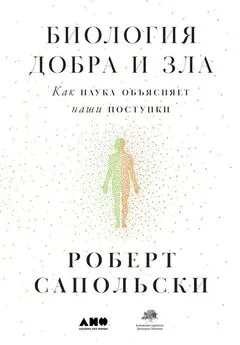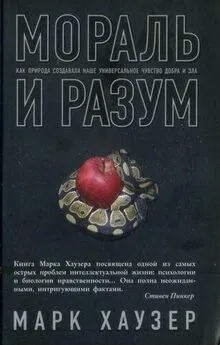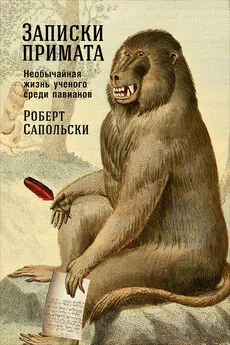Роберт Сапольски - Биология добра и зла. Как наука объясняет наши поступки
- Название:Биология добра и зла. Как наука объясняет наши поступки
- Автор:
- Жанр:
- Издательство:Альпина нон-фикшн
- Год:2019
- Город:Москва
- ISBN:978-5-0013-9051-0
- Рейтинг:
- Избранное:Добавить в избранное
-
Отзывы:
-
Ваша оценка:
Роберт Сапольски - Биология добра и зла. Как наука объясняет наши поступки краткое содержание
Биология добра и зла. Как наука объясняет наши поступки - читать онлайн бесплатно ознакомительный отрывок
Интервал:
Закладка:
652
К сноске: S. Boria, Animals in the Third Reich: Pets, Scapegoats, and the Holocaust (Providence, RI: Yogh and Thorn Books, 2000).
653
A. Rutland and R. Brown, “Stereotypes as Justification for Prior Intergroup Discrimination: Studies of Scottish National Stereotyping,” Eur J Soc Psych 31 (2001): 127.
654
C. S. Crandall et al., “Stereotypes as Justifications of Prejudice,” PSPB 37 (2011): 1488.
655
R. Niebuhr, The Nature and Destiny of Man , vol. 1 (London: Nisbet, 1941); B. P. Meier and V. B. Hinsz, “A Comparison of Human Aggression Committed by Groups and Individuals: An Interindividual Intergroup Discontinuity,” JESP 40 (2004): 551; T. Wildschut et al., “Beyond the Group Mind: A Quantitative Review of the Interindividual-Intergroup Discontinuity Effect,” Psych Bull 129 (2003): 698.
656
T. Cohen et al., “Group morality and Intergroup Relation: Cross-Cultural and Experimental Evidence,” PSPB 32 (2006): 1559; T. Wildschut et al., “Intragroup Social Influence and Intergroup Competition,” JPSP 82 (2002): 975.
657
S. Bowles, “Conflict: Altruism’s Midwife,” Nat 456 (2008): 326.
658
M. Shih et al., “Stereotype Susceptibility: Identity Salience and Shifts in Quantitative Performance,” Psych Sci 10 (1999): 80; T. Harada et al., “Dynamic Social Power Modulates Neural Basis of Math Calculation,” Front Hum Nsci 6 (2012): 350; J. Van Bavel and W. Cunningham, “Self-Categorization with a Novel Mixed-Race Group Moderates Automatic Social and Racial Biases,” PSPB 35 (2009): 321; G. Bohner et al., “Situational Flexibility of In-group-Related Attitudes: A Single Category IAT Study of People with Dual National Identity,” Group Processes & Intergroup Relations 11 (2008): 301.
659
N. Jablonski, Skin: A Natural History (Oakland, CA: University of California Press, 2006): A. Gibbons, “Shedding Light on Skin Color,” Sci 346 (2014): 934.
660
R. Hahn, “Why Race Is Differentially Classified on U.S. Birth and Infant Death Certificates: An Examination of Two Hypotheses,” Epidemiology 10 (1999): 108.
661
C. D. Navarrete et al., “Fear Extinction to an Out-group Face: The Role of Target Gender,” Psych Sci 20 (2009): 155; J. P. Mitchell et al., “Contextual Variations in Implicit Evaluation,” J Exp Psych: General 132 (2003): 455; последняя работа касается сравнения политиков и спортсменов.
662
R. Kurzban et al., “Can Race Be Erased? Coalitional Computation and Social Categorization,” PNAS 98 (2001): 15387.
663
M. E. Wheeler and S. T. Fiske, “Controlling Racial Prejudice: Social-Cognitive Goals Affect Amygdala and Stereotype Activation,” Psych Sci 16 (2005): 56; J. P. Mitchell et al., “The linkh Between Social Cognition and Self-Referential Thought in the Medial Prefrontal Cortex,” J Cog Nsci 17 (2005): 1306.
664
M. A. Halleran, The Better Angels of Our Nature: Freemasonry in the American Civil War (Tuscaloosa AL: University of Alabama Press, 2010).
665
T. Kenneally, The Great Shame: And the Triumph of the Irish in the English-Speaking World (New York: Anchor Books, 2000).
666
Patrick Leigh Fermor obituary, Daily Telegraph (London), June, 11, 2011. Материал про воссоединение с Крайпе, см. “H A∏AΓΩΓH TOY ΣTPATHΓOY KPAI∏E,” загруженный пользователем Idomeneas Kanakakis 21 октября 2010 г., www.youtube.com/watch?v=8zlUhJwddFU. Документальные съемки про похищение и путешествие, см. “The Abduction of Gengeral Kreipe.avi,” загруженное пользователем Nico Mastorakis 25 февраля 2012 г., www.youtube.com/watch?v=vN1qrghgCqI.
667
E. Krusemark and W. Li, “Do All Threats Work the Same Way? Divergent Effects of Fear and Disgust on Sensory Perception and Attention,” J Nsci 31 (2011): 3429.
668
К сноске: M. Plitt et al., “Are Corporations People Too? The Neural Correlates of Moral Judgments About Companies and Individuals,” Social Nsci 10 (2015): 113.
669
S. Fiske et al., “A Model of (Often Mixed) Stereotype Content: Competence and Warmth Respectively Follow from Perceived Status and Competition,” JPSP 82 (2002): 878; L. T. Harris and S. T. Fiske, “Dehumanizing the Lowest of the Low: Neuroimaging Responses to Extreme Out-groups,” Psych Sci 17 (2006): 847; L. T. Harris and S. T. Fiske, “Social Groups That Elicit Disgust Are Differentially Processed in mPFC,” SCAN 2 (2007): 45. см. также: S. Morrison et al., “The Neuroscience of Group Membership,” Neuropsychologia 50 (2012): 2114.
670
T. Ashworth, Trench Warfare: 1914–1918 (London: Pan Books, 1980).
671
K. B. Clark and M. P. Clark, “Racial Identification and Preference Among Negro Children,” in Readings in Social Psychology , ed. E. L. Hartley (New York: Holt, Rinehart, and Winston, 1947); K. Clark and C. Mamie, “The Negro Child in the American Social Order,” J Negro Education 19 (1950): 341; J. Jost et al., “A Decade of System Justification Theory: Accumulated Evidence of Conscious and Unconscious Bolstering of the Status Quo,” Political Psych 25 (2004): 881; J. Jost et al., “Non-conscious Forms of System Justification: Implicit and Behavioral Preferences for Higher Status Groups,” JESP 38 (2002): 586.
672
S. Lehrman, “The Implicit Prejudice,” Sci Am 294 (2006): 32.
673
K. Kawakami et al., “Mispredicting Affective and Behavioral Responses to Racism,” Sci 323 (2009): 276; B. Nosek, “Implicit-Explicit Relations,” Curr Dir Psych Sci 16 (2007): 65; L. Rudman and R. Ashmore, “Discrimination and the Implicit Association Test,” Group Processes & Intergroup Relations 10 (2007): 359; J. Dovidio et al., “Implicit and Explicit Prejudice and Interracial Interaction,” JPSP 82 (2002): 62. По поводу подхода к раскрытию скрытых предвзятостей см. I. Blair, “The Malleability of Automatic Stereotypes and Prejudice,” PSPR 6 (2002): 242.
674
W. Cunningham et al., “Separable Neural Components in the Processing of Black and White Faces,” Psych Sci 15 (2004): 806; W. A. Cunningham et al., “Neural Correlates of Evaluation Associated with Promotion and Prevention Regulatory Focus,” Cog, Affective & Behav Nsci 5 (2005): 202; K. M. Knutso et al., “Neural Correlates of Automatic Beliefs About Gender and Race,” Hum Brain Mapping 28 (2007): 915.
675
B. K. Payne, “Conceptualizing Control in Social Cognition: How Executive Functioning Modulates the Expression of Automatic Stereotyping,” JPSP 89 (2005): 488.
676
J. Dovidio et al., “Why Can’t We Just Get Along? Interpersonal Biases and Interracial Distrust,” Cultural Diversity & Ethnic Minority Psych 8 (2002): 88.
677
J. Richeson et al., “An fMRI Investigation of the Impact of Interracial Contact on Executive Function,” Nat Nsci 12 (2003): 1323; J. Richeson and J. Shelton, “Negotiating Interracial Interactions: Cost, Consequences, and Possibilities,” Curr Dir Psych Sci 16 (2007): 316.
678
J. N. Shelton et al., “Expecting to Be the Target of Prejudice: Implications for Interethnic Interactions,” PSPB 31 (2005): 1189.
679
P. M. Herr, “Consequences of Priming: Judgment and Behavior,” JPSP 51 (1986): 1106; N. Dasgupta and A. Greenwald, “On the Malleability of Automatic Attitudes: Combating Automatic Prejudice with Images of Admired and Disliked Individuals,” JPSP 81 (2001): 800.
680
W. A. Cunningham et al., “Rapid Social Perception Is Flexible: Approach and Avoidance Motivational States Shape P100 Responses to Other-Race Faces,” Front Hum Nsci 6 (2012): 140.
681
A. D. Galinsky and G. B. Moskowitz, “Perspective-Taking: Decreasing Stereotype Expression, Stereotype Accessibility, and In-group Favoritism,” JPSP 78 (2000): 708; I. Blair et al., “Imagining Stereotypes Away: The Moderation of Implicit Stereotypes Through Mental Imagery,” JPSP 81 (2001): 828; T. J. Allen et al., “Social Context and the Self-Regulation of Implicit Bias,” Group Processes & Intergroup Relations 13 (2010): 137; J. Fehr and K. Sassenberg, “Willing and Able: How Internal Motivation and Failure Help to Overcome Prejudice,” Group Processes & Intergroup Relations 13 (2010): 167.
682
C. Macrae et al., “The Dissection of Selection in Person Perception: Inhibitory Processes in Social Stereotyping,” JPSP 69 (1995): 397.
683
T. Pettigrew and L. A. Tropp, “A Meta-analytic Test of Intergroup Contact Theory,” JPSP 90 (2006): 751.
684
A. Rutherford et al., “Good Fences: The Importance of Setting Boundaries for Peaceful Coexistence,” PLoS ONE 9 (2014): e95660; L. G. Babbitt and S. R. Sommers, “Framing Matters: Contextual Influences on Interracial Interaction Outcomes,” PSPB 37 (2011): 1233.
685
M. J. Williams and J. L. Eberhardt, “Biological Conceptions of Race and the Motivation to Cross Racial Boundaries,” JPSP 94 (2008): 1033.
686
G. Hodson et al., “A Joke Is Just a Joke (Except When It Isn’t): Cavalier Humor Beliefs Facilitate the Expression of Group Dominance Motives,” JPSP 99 (2010): 460; F. Pratto and M. Shih, “Social Dominance Orientation and Group Context in Implicit Group Prejudice,” Psych Sci 11 (2000): 515; F. Pratto et al., “Social Dominance Orientation and the Legitimization of Inequality Across Cultures,” J Cross-Cultural Psych 31 (2000); 369; F. Durante et al., “Nations’ Income Inequality Predicts Ambivalence in Stereotype Content: How Societies Mind the Gap,” Brit J Soc Psych 52 (2012): 726; A. C. Kay and J. T. Jost, “Complementary Justice: Effects of ‘Poor but Happy’ and ‘Poor but Honest’ Stereotype Exemplars on System Justification and Implicit Activation of the Justice Motive,” JPSP 85 (2003): 823; A Kay, et al., “Victim Derogation and Victim Enhancement as Alternate Routes to System Justification,” Psych Sci 16 (2005): 240.
687
C. Sibley and J. Duckitt, “Personality and Prejudice: A Meta-analysis and Theoretical Review,” PSPR 12 (2008): 248.
688
Интервал:
Закладка:





![Роберт Сапольски - Игры тестостерона и другие вопросы биологии поведения [litres]](/books/1074102/robert-sapolski-igry-testosterona-i-drugie-vopros.webp)




